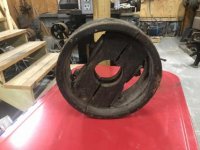DeSelle
Cast Iron
- Joined
- Oct 23, 2006
- Location
- Midlothian, TX
Hi all,
With much help from several members here, I have been working towards my goal of setting up a lineshaft to power my collection of antique machinery.
I have the shaft up and am sorting out the pulleys. My original intent was to use some of the metal pulleys I have collected but I now realize they are all off counter shafts and the bores are too small for the lineshaft. The hubs are not big enough to bore out to the 1-15/16 diameter of the lineshaft. I have a dozen or so wooden pulleys of the correct sizes that were on the lineshafts when I took them down. And here is where I need advice:
The pulleys I have are fairly rough. I would love to restore these and use them but I have limited woodworking skills. Looking at the pictures some appear to be in good shape just needing a good clean (how?) and some light machining? Others need some re-gluing? Is there some kind of thin glue you can brush on that will soak in and adhere everything together? Or do I have to completely disassemble them and rebuild like a jigsaw puzzle?
Thanks as always for all the help,
Nathan










With much help from several members here, I have been working towards my goal of setting up a lineshaft to power my collection of antique machinery.
I have the shaft up and am sorting out the pulleys. My original intent was to use some of the metal pulleys I have collected but I now realize they are all off counter shafts and the bores are too small for the lineshaft. The hubs are not big enough to bore out to the 1-15/16 diameter of the lineshaft. I have a dozen or so wooden pulleys of the correct sizes that were on the lineshafts when I took them down. And here is where I need advice:
The pulleys I have are fairly rough. I would love to restore these and use them but I have limited woodworking skills. Looking at the pictures some appear to be in good shape just needing a good clean (how?) and some light machining? Others need some re-gluing? Is there some kind of thin glue you can brush on that will soak in and adhere everything together? Or do I have to completely disassemble them and rebuild like a jigsaw puzzle?
Thanks as always for all the help,
Nathan











